About the Duke
The Beechcraft Duke B60 is a pressurized, turbocharged, twin engine
aircraft with retractable landing gear that first flew in 1966.
The B60 was the final variant of the Duke with the 60 and A60
being made pre-1975. 584 aircraft were built, around 350 or
these being B60's with production finishing in 1982. The B60 is
regarded as the best developed of this series, but due to the
complexities of the design, the cost of running and the
servicing requirement relatively few aircraft were purchased.
It accommodates 4 to 6 passengers with typically 1 passenger
sitting in the cockpit beside the pilot and 4 passengers in the
back of the cabin in a club-seating arrangement.
The engines on the final version were turbocharged Lycoming
TIO-542's producing a maximum of 380hp each. Either engine
was capable of maintaining cabin pressure which was good up to
at least 25,000 feet where it could maintain a cabin pressure of
10,000.
About RealAir
RealAir are one of those innovative aircraft developers that everyone loves. Not happy with
the shortfalls or the default flight sim engine, they try to add
new dimensions for the experiences of the GA flyer. RealAir
have pioneered the development of smooth gauges, accurate stall
& spin behaviour, slide slipping and RealView which gives the
pilot that sense of being there by simulating forces
experienced in the real world such as stall buffeting.
Features
• High resolution exterior textures with bump
mapping
• 3D Ultra-smooth gauge animation
• Accurate simulation of the Duke's pressurised cabin
• Reflections on cockpit glass
• Well-equipped IFR panels
• Visual stall-buffet effect
• Accurate single-engine asymmetrical performance and handling
• Realistic side-slipping
• Realistic stall handling
• Accurate performance figures (cruise, climb, takeoff, stall
speed etc)
• Accurate engine handling characteristics (fuel flow, CHT etc)
• A high-fidelity sound suite
• Comprehensive documentation
• Optional Reality XP GNS WAAS 530/430 Integration
Installation and
setup
My Duke B60 is the boxed version so no downloading involved and
I have a nice colourful dvd box to add to my collection! The box
comes with a nicely presented manual which holds most of the
things you need to know. After installation you have the RealAir
manual, charts and checklists in pdf format available.
The first thing I did, as I do with all my aircraft, is to print
out the check list for easy reference, there's nothing worse
when on approach than trying to get the kneeboard up on the
display or trying to navigate to the pdf file and write down or
remember the check points!
Auto-run takes you to the welcome screen which guides you through
the installation and should auto detect your FSX folder, it does
allow for an override if you do not have your flight sim on your
C drive.
In familiar RealAir fashion there is a configuration utility,
the first tab has links back to all the installed manuals for
reference and to the RealAir website where you can help help on
their support forums.
The options tab allows you to set nose wheel steering, GPS on
startup, DME indicator and VS glass reflections. Also here there
are settings for cold & dark or a fully running start up
and a strength setting for the stall buffeting.
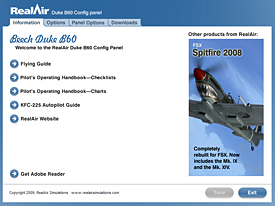 |
 |
 |
The panel tab allows you to change the way the mouse interacts
with the controls by either click and drag or left/right mouse
button. For those of you fortunate to have the Reality XP GNS
430 and 530 units you can set the integration and layout options
here.
Finally, there is a tab for download and updates which, if you
are connected to the internet will allow you to update your
system.
Once you have finished in the Config Utility you will need to
set your sim realism to maximum and the p-factor /Torque slider
to 75& or more as the flight model relies on this for accuracy.
External Model
There are two versions modelled, one with winglets and one
without. Both have a single vortex generator on the
leading edge near to the tip to help reduce the possibility of
flow separation over the wing.
The Duke comes with 7 texture variations, 5 North American, one
German and one Canadian, I would have like to have seen at least
one British livery in the package. I haven't seen a paint
kit available yet for the more creative of us but I am sure one
will come along eventually.
Being a true FSX model it takes good advantage of bump and
specular mapping. As you can see from the banner shot above it
really gives the feeling of depth to the panels and rivets.
It has Nice bright spinners and prop animation
in flight with a believable smoke
puff on start up.
| The animation of the cowls, flaps and doors is very smooth.
The Doors will not fully open above 30kts, if you should be careless to leave it open on take off, it will be blown shut by the force of the wind, illustrated in the short video clip to the right! The animation of the nose wheel twisting 90°just before the door closes is very nicely done indeed. However, I was (at first) disappointed not to see any prop feathering animation, so I took to the manual. The real Duke doesn't feather the prop when it has stopped, the prop angle actuators only work when the propeller are spinning. So that was the best response to that query. I feel sure they have been and will be dogged by that question, R.T.(Choose adequate word).M!! |
I tried this out by feathering first then leaning the engine and closing the throttle. Sure enough it stopped feathered and could be seen to be so.

VC or not VC?
Well there is no option here as there is no 2D option.
Living in a multi-dimensional world I prefer using the VC,
however, a lot of people don't, especially when flying IFR
and
looking out of the widow is no use, then and you need good clear
displays.
RealAir are the masters of smooth flowing 3D gauges, they are
astonishingly clear, this should help to placate the 2D
enthusiasts. Most of the gauges and radios modelled would
not be found in the original Dukes but reflect the sort of
updated equipment you would fly in the real world such as Bendix/King
gauges and digital radio equipment.
The VC comes with left click spots to take
you to a closer up view of that area and a right click to always
take to back to the main view. Try clicking in the coloured
regions below to see the view.
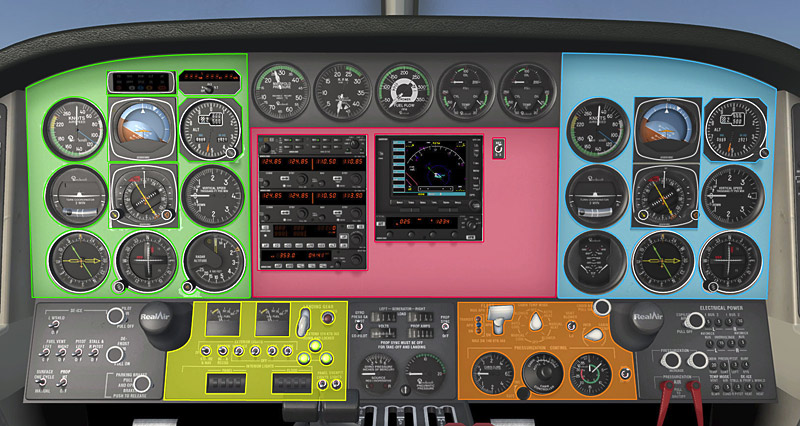 |
||||
|
|
|
‘Co-pilot’ view |
|
|
The default Garmin 500 GPS system allied to the autopilot is
quite good enough and the most familiar for most FS pilots.
There is an option to plug in the RealityXP GNS WAAS 530 and/or
the GNSWAAS 430. Not owning this unit I cannot comment on how it
interfaces with the Duke. Be sure to check the
instructions though as incorrect set up can result in blank
panels.
Operating the switches is easy enough if you are familiar with
flying from the VC but also easy to pick up if you are not.
I find it easier to fly in the VC with the yokes hidden so you
can see the switches behind. If you use the excellent
TrackIR you can look around them of course. I figure that
I have the yoke bolted to my desk so I don't need to see it on
the screen.
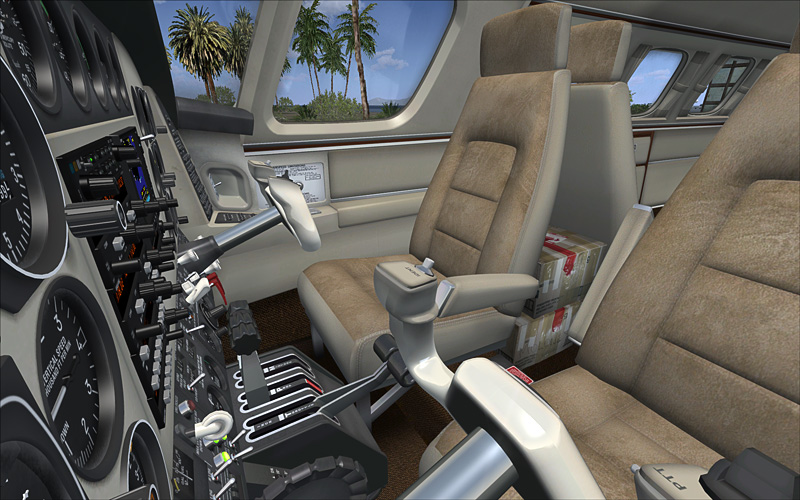
Now that's what I call a great 3D view!
Flying the Duke
The emphasis here is on realism so lets give her a spin.
Following the check lists to start her up is easy enough, she's
pretty straight forward to fly, almost as easy as a single.
RealAir were good enough to model stall buffeting, spins and
slide-slipping and gear-up landings so I just had to try them
all!
Taxiing with differential brakes is my my choice I think the
Duke would be good at a slalom. Take off with one notch of
flap is the way to go. Not much trim is required although I
found her hesitant to rotate at her 90kt target, perhaps I
wasn't pulling back hard enough or a little more trim could have
been added.
Although I had the realism settings to max the torque effect
soon dissipates on the roll and didn't require much input from
the right rudder to keep her straight. After rotate the
AoA does accentuate the p-factor again but only momentarily.
Flipping the gear lever results in a wonderful clattering and
whirring of the gear in a very wide spatial sound quality.
This is thanks to another feature of this product that adds a
true stereo quality to most of the sounds that are modelled.
With everything cleaned up the response from input via the yoke
and pedals is very sure and smooth. She didn't require too
much trimming to keep her level. The autopilot was very
good and followed a flight plan without deviation. It
accurately maintains the height you dial in too. It was
all very calm with no surprises.
| So I could just sit back and let George fly but what
about the stall buffeting? Sure enough, nose up, throttle back the speed dropping below 70kts the stall buzzer alerts us to the onset of the buffeting. The tendency for a spin to follow unless you nose down and throttle up immediately was quite worrying but accurate and resulted in taking recovery actions of neutral ailerons and opposite rudder. I got into a few spins trying out the stall and the rate of the loss of altitude is very alarming, stay calm and keep as much height as you can! |
Next up was the asymmetric flying, to make the
effect worse I shut down the left engine, this should make the
torque more noticeable. Certainly the yaw was very
noticeable, after featuring the prop. (See picture above) I was
now flying with one foot on the rudder, a bit like the wife
resting her foot on the clutch pedal! Be sure not to
increase the AoA as this will make things worse needing more
rudder input.
The secondary affect of the right rudder is to make the aircraft
bank so some opposite aileron is required as well to keep her
straight. The inclinometer shows the ball to the right and
the wings to the left but with only one engine the result is
zero slip. Actually it wasn't that bad, returning to the
airfield and landing was straight forward enough once you get
used to it.
So on to side-slipping proper. On another sortie with both
engines I tried this out on approach to bleed off the speed, it
seems unnatural to apply opposite rudder to aileron the
inclinometer shows the ball to the right and the wings to the
left and in a twin not really recommended for more than 30
seconds as it inhibits airflow through the engine on the
opposite side.
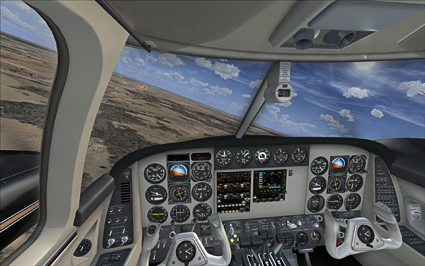 |
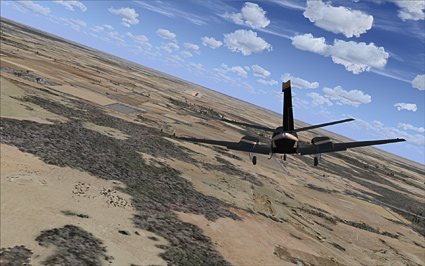 |
Finally with much trepidation I tried gear up
landing on grass and on water. You will be pleased to know
I made it safely down thanks to my realism setting of ignore
crashes. Not my favourite manoeuvre and one I hope I never have to
experience in real life but the sparks, dirt and water flying up
were impressive.
After trying out all the "extreme" manoeuvres the Duke is happy
to go any where you point her (Or should I say him?!)
![]() Verdict
Verdict
Short in fancy animations and frills but tall in
realism. Test flying the Duke now for more than 5 hours has
made me a real fan and presently this is my twin of choice.
A very high quality exterior model although I would liked to
have seen more liveries for the flight simmer that does not
live in North America.
You have to hand it to RealAir, their dedication to produce
accurate sims has more than been demonstrated here.
This simulation will get you wanting to fly twins all the
time
I would score this one 8.5 /10 - very impressive.
![]()
/Joe Lawford

